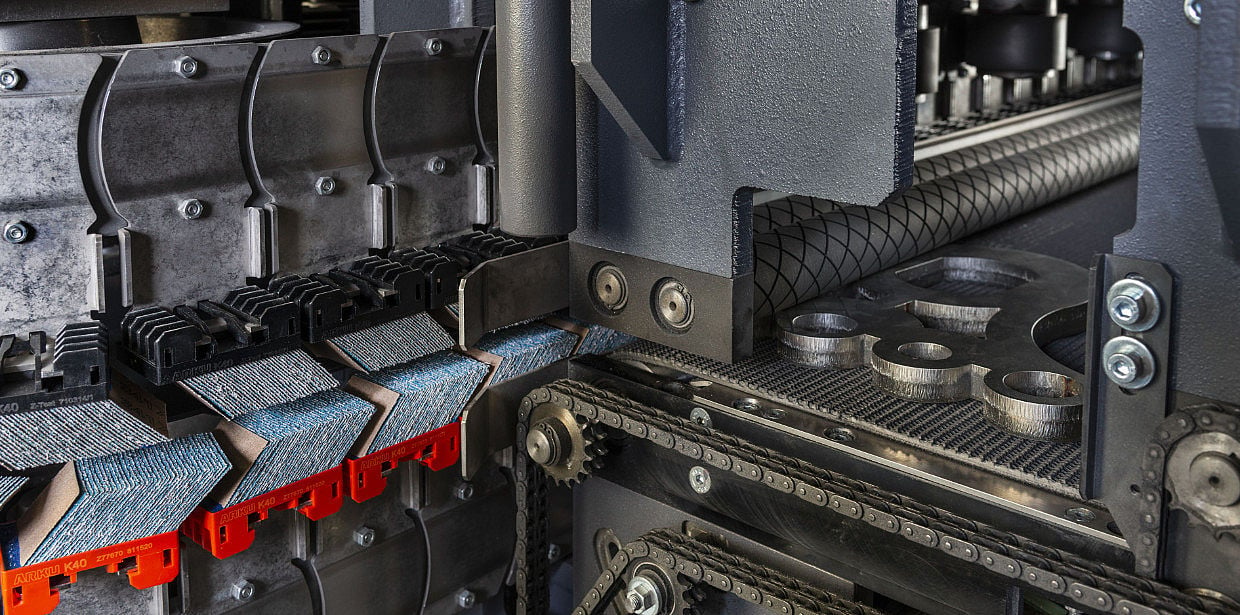1. Process Deburring
Burrs are unavoidable whenever metal is cut: These usually consist of small, sharp material residues protruding from the cutting edge. They can injure people, damage equipment or may cause disturbances during the production process. That is why customers now often ask for burr-free parts.
If components are made of thin sheet metal, then the best deburring tools are brushes or abrasive belts. Sanding units supported by a contact roller will grind away at the protruding burr on the sheet. Brush deburring machines on the other hand will remove protruding excess material by driving the brushes along the edge of the materials. The brushes remove the burrs while at the same time rounding the edges (see process 4).
However, the thicker the material is, the bigger the burr will become during cutting. These tough burrs are efficiently dealt with by the grinding drum, which can also remove millimeter-thick burrs.
2. Process: Slag removal
The thicker the metal the more difficult it is to cut. Plasma or oxy-fuel cutting requires high energy input in order to cut through the heavy plates. Thus, creating a 3 millimeter long or potentially even larger dross/slag. They form where the cutting jet emerges from the material.
Just like burrs, dross and slag can also damage machinery and tools in subsequent processes or complicate further processing. At the very least, this thick thermal slag is relatively easily chipped off. The fastest and most convenient method is the slag hammer.
Here, it is important that initially the thermal slag is not ground off. The large volume involves so much material that would quickly clog the abrasives. Depending on the procedure, the slag would only be flattened or rolled over. Experts can assess quickly whether a workpiece should be worked with the slag hammer first or whether deburring is possible right away.
Some smaller slag may still be present on the workpiece after the slag hammer process. Those cannot be chipped off easily, but they can be removed by means of a grinding drum, abrasive belt, brushes or a conventional deburring machine.
Summary of the most important deburring techniques
Deburred sheet metal parts today are a sign of quality and a must-have to remain competitive. We will give you an overview of all the important deburring methods and techniques.
3. Process: Edge rounding
Removing burrs leaves behind sharp edges. This sharp edge is removed by a subsequent process classified as edge rounding. This means: When deburring sheet metal, edges are always rounded as well.
Depending on final usage of the processed materials, a small radius of .10 millimeters is often enough for rounding the metal edge. In this instance, not only cuts are avoided when employees handle the materials. Additionally, once the edges are rounded, they will not cause any damage to a pneumatic hoses or cables as well.
The requirements for coatings are higher: For the proper paint adhesion and proper functioning of the corrosion protection, a rounding radius of 0.3 mm or more is often required. Some standards even require 2.0 millimeters.
Utilizing a tumbler is an alternative for edge rounding small parts. Here, not only the edges are worked but the entire component. However, for larger sheet metal parts, there is no reasonable alternative to edge rounding with brushes.
4. Process: Surface finish
A deburring machine acts on the entire sheet that passes through. Due to the design, it is inevitable that brushes or abrasive belts will alter the sheet metal surface.
Therefore the materials will always have some surface texture after deburring. Some operators or customers are satisfied with the visual appearance as is when the material comes out of the machine - others are not. In such cases it can make sense to add a finishing module to the deburring machine.
Finishing with the deburring machine takes place after edge rounding.
The finishing module itself has a very fine-grained abrasive belt or nonwoven abrasive. The abrasive belt or fleece is passed around two rollers, so that it can specifically target the metal surface. That way, operators will achieve a uniform and appealing appearance. Professionals refer to these lines as a “grained” type finish. With rotor brushes however, operators achieve a non-directional finish, that is a matte finish. In circular motion, the brushes process the metal surface from a different direction over and over again.
5. Process: Removal of oxide layers
Oxygen used in cutting leaves behind and an oxide layer on the cutting edges. This layer has other properties than the base material, which may impact further processing.
Deburring machines can also be used to remove an oxide layer from a cut edge. These types of machines are already designed for edge processing anyhow. Even though deburring and the removal of the oxide layer are indeed two different processes, both can work well in one system.
The tools used for removing the oxide layer on the cutting edges usually consist of wire type brushes. Those can also remove deposits that stick to the surface, which can happen depending on the alloy used.



